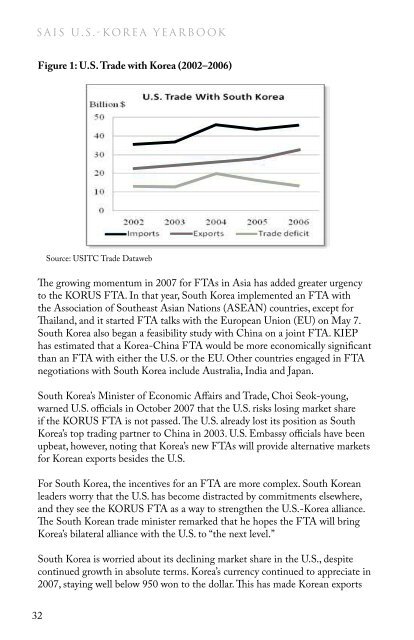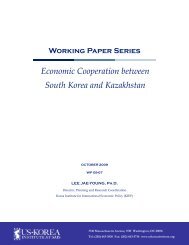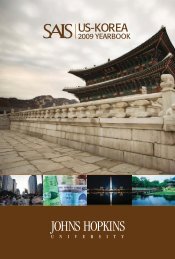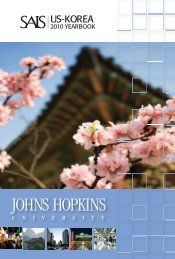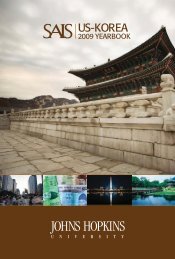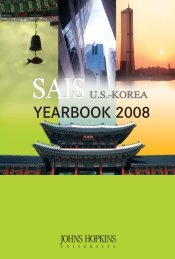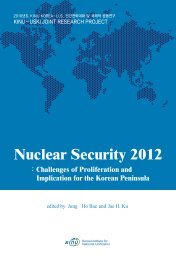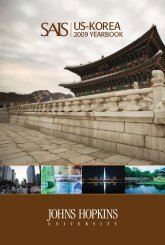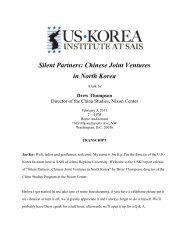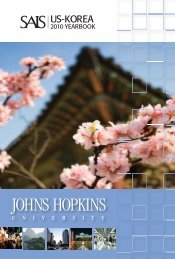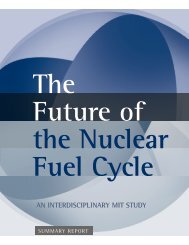YeArBooK 2007 - US-Korea Institute at SAIS
YeArBooK 2007 - US-Korea Institute at SAIS
YeArBooK 2007 - US-Korea Institute at SAIS
Create successful ePaper yourself
Turn your PDF publications into a flip-book with our unique Google optimized e-Paper software.
saIs U.s.-<strong>Korea</strong> YearbooK<br />
32<br />
figure 1: U.S. Trade with <strong>Korea</strong> (2002–2006)<br />
Source: <strong>US</strong>ITC Trade D<strong>at</strong>aweb<br />
The growing momentum in <strong>2007</strong> for FTAs in Asia has added gre<strong>at</strong>er urgency<br />
to the KOR<strong>US</strong> FTA. In th<strong>at</strong> year, South <strong>Korea</strong> implemented an FTA with<br />
the Associ<strong>at</strong>ion of Southeast Asian N<strong>at</strong>ions (ASEAN) countries, except for<br />
Thailand, and it started FTA talks with the European Union (EU) on May 7.<br />
South <strong>Korea</strong> also began a feasibility study with China on a joint FTA. KIEP<br />
has estim<strong>at</strong>ed th<strong>at</strong> a <strong>Korea</strong>-China FTA would be more economically significant<br />
than an FTA with either the U.S. or the EU. Other countries engaged in FTA<br />
negoti<strong>at</strong>ions with South <strong>Korea</strong> include Australia, India and Japan.<br />
South <strong>Korea</strong>’s Minister of Economic Affairs and Trade, Choi Seok-young,<br />
warned U.S. officials in October <strong>2007</strong> th<strong>at</strong> the U.S. risks losing market share<br />
if the KOR<strong>US</strong> FTA is not passed. The U.S. already lost its position as South<br />
<strong>Korea</strong>’s top trading partner to China in 2003. U.S. Embassy officials have been<br />
upbe<strong>at</strong>, however, noting th<strong>at</strong> <strong>Korea</strong>’s new FTAs will provide altern<strong>at</strong>ive markets<br />
for <strong>Korea</strong>n exports besides the U.S.<br />
For South <strong>Korea</strong>, the incentives for an FTA are more complex. South <strong>Korea</strong>n<br />
leaders worry th<strong>at</strong> the U.S. has become distracted by commitments elsewhere,<br />
and they see the KOR<strong>US</strong> FTA as a way to strengthen the U.S.-<strong>Korea</strong> alliance.<br />
The South <strong>Korea</strong>n trade minister remarked th<strong>at</strong> he hopes the FTA will bring<br />
<strong>Korea</strong>’s bil<strong>at</strong>eral alliance with the U.S. to “the next level.”<br />
South <strong>Korea</strong> is worried about its declining market share in the U.S., despite<br />
continued growth in absolute terms. <strong>Korea</strong>’s currency continued to appreci<strong>at</strong>e in<br />
<strong>2007</strong>, staying well below 950 won to the dollar. This has made <strong>Korea</strong>n exports<br />
<strong>Korea</strong>-U.s. fTa faCes UnCerTaIn fUTUre<br />
less competitive and even small tariff r<strong>at</strong>es painful. Trade accounts for 70 percent<br />
of <strong>Korea</strong>’s GDP, and South <strong>Korea</strong>n leaders see guaranteeing export markets as<br />
an economic imper<strong>at</strong>ive. South <strong>Korea</strong>n officials also see an FTA with the U.S. as<br />
improving their bargaining position in FTA talks with other countries. Current<br />
FTA talks with the EU suggest this str<strong>at</strong>egy may be working.<br />
Just as significant from an economic perspective is the gain for <strong>Korea</strong>n<br />
consumers. High agricultural tariffs in South <strong>Korea</strong> have made <strong>Korea</strong>n<br />
agricultural products some of the most expensive in the world. The price of<br />
beef in South <strong>Korea</strong> has <strong>at</strong> times surpassed even Japan’s famously high prices.<br />
The U.S. is South <strong>Korea</strong>’s top foreign supplier of agricultural products, and the<br />
KOR<strong>US</strong> FTA is predicted to decrease the prices paid by <strong>Korea</strong>n consumers.<br />
II. neGoTIATIonS And THe CHAnGInG PolITICAl lAndSCAPe<br />
The KOR<strong>US</strong> FTA negoti<strong>at</strong>ions got off to a rocky start in <strong>2007</strong>. Seoul was<br />
rocked by anti-FTA protests in January, requiring the deployment of 15,000 riot<br />
police. Nine South <strong>Korea</strong>n progressive lawmakers announced a five-day hunger<br />
strike, calling for a halt to negoti<strong>at</strong>ions. Farmers, the film industry and labor<br />
unions denounced negoti<strong>at</strong>ions, opposing relax<strong>at</strong>ion of quotas and other barriers<br />
to trade.<br />
President Roh Moo-hyun, a politician who once boasted proudly of his lack of<br />
connections to the U.S., has been the driving force behind r<strong>at</strong>ific<strong>at</strong>ion of the<br />
KOR<strong>US</strong> FTA in <strong>Korea</strong>. His support for the FTA has caused deep divisions<br />
within the traditionally progressive Uri Party, of which he was a member. In<br />
February <strong>2007</strong>, a group of legisl<strong>at</strong>ors left the Uri Party, and another group left<br />
in May to form their own party. Internal politics caused the Uri Party to break<br />
apart and re-form as the United New Democr<strong>at</strong>ic Party (UNDP). UNDP<br />
n<strong>at</strong>ional committeewoman Suh Hae Suk admitted in November th<strong>at</strong> the FTA<br />
has been a “hard issue within our party.”<br />
President Roh has managed to boost support for the FTA despite low approval<br />
r<strong>at</strong>ings. The percentage of South <strong>Korea</strong>ns who express support for the KOR<strong>US</strong><br />
FTA in public opinion polls went from around 30 percent in mid-2006 to nearly<br />
60 percent a year l<strong>at</strong>er. The president’s approval r<strong>at</strong>ing shot up to 32 percent—a<br />
10-point jump—when the KOR<strong>US</strong> FTA agreement was reached.<br />
In Washington, D.C., the Democr<strong>at</strong>ic Party used its new majority to refocus the<br />
deb<strong>at</strong>e over U.S. trade policy away from President Bush’s emphasis on free trade<br />
and toward labor and environmental concerns. On March 27, <strong>2007</strong>, Charles<br />
Rangel (D-NY) and Sander Levin (D-MI) announced the Democr<strong>at</strong>ic Party’s<br />
new trade str<strong>at</strong>egy, titled “A New Trade Policy for America.” The policy called on the<br />
33


